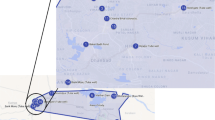Abstract
A recently published method for quantifying refractory organic matter (often referred to as humic substances) in freshwaters was applied to a wide range of International Humic Substance Society (IHSS) humic compounds in order to (i) gain a better understanding of the mechanism of the voltammetric response which is the basis of the analytical method and (ii) provide guidance on choosing the optimal standard to be used. At the same time, the sensitivity of the technique has been increased by switching from the pulse mode initially proposed to the square-wave mode. The results obtained show that (i) differences in adsorption onto the electrode rather than differences in complexation strength are responsible for the differences in the intensity of the signal obtained for the different humic compounds, (ii) carboxylate, N- and S-containing groups do not play a role in the voltammetric signal.





Similar content being viewed by others
References
Filella M (2008) Environ Chem Lett. doi:10.1007/s10311-008-0158-x
Abbt-Braun G, Lankes U, Frimmel FH (2004) Aquat Sci 66:151–170
Weishaar JL, Aiken GR, Bergamaschi BA, Fram MS, Fujii R, Mopper K (2003) Environ Sci Technol 37:4702–4708
Baron J, McKnight D, Denning AS (1991) Biogeochemistry 15:89–110
McKnight DM, Aiken GR, Smith RL (1991) Limnol Oceanogr 36:998–1006
McKnight DM, Bencala KE, Zellweger GW, Aiken GR, Feder GL, Thorn KA (1992) Environ Sci Technol 26:1388–1396
McKnight DM, Andrews ED, Spulding SA, Aiken GR (1994) Limnol Oceanogr 39:1972–1979
McKnight DM, Harnish R, Wershaw RL, Baron JS, Schiff S (1997) Biogeochemistry 36:99–124
Volk CJ, Volk CB, Kaplan LA (1997) Limnol Oceanogr 42:39–44
van Zomeren A, Comans RNJ (2007) Environ Sci Technol 41:6755–6761
Wu FC, Evans RD, Dillon PJ, Cai YR (2007) Appl Geochem 22:1598–1605
Chanudet V, Filella M, Quentel F (2006) Anal Chim Acta 569:244–249
Chanudet V, Filella M (2007) Org Geochem 38:1146–1160
Filella M, Chanudet V, Quentel F (2008) Freshwaters: do ‘humics’ always represent 50% of NOM? In: Perminova IV, Kulikova NA (eds) Proceedings of the 14th International Meeting of the International Humic Substances Society, September 14–19, 2008, Moscow–Saint Petersburg, Russia, Humus Sapiens, Moscow, 2008, pp 151–154
Aiken GR (1985) Geochemistry and isolation. In: Aiken GR, McKnight DM, Wershaw RL, MacCarthy P (eds) Humic substances in soil, sediment and water. Wiley-Interscience, New York
Thurman EM, Malcolm RL (1981) Environ Sci Technol 15:463–466
Serkiz SM, Perdue EM (1990) Water Res 24:911–916
Swift RS (1996) In: Sparks DL (ed) Methods of soil analysis. Part 3. Chemical methods. Soil Science Society America, American Society of Agronomy, Madison, pp 1011–1069
Quentel F, Elleouet C (2001) Electroanalysis 13:1030–1035
Kolthoff IM, Lingane JJ (1952) Polarography, vol 1. Interscience, New York
Limousin G, Gaudet JP, Charlet L, Szenknect S, Barthès V, Krimissa M (2007) Appl Geochem 22:249–275
Acknowledgements
We would like to thank Thomas Meinelt (Leibniz-Institut of Freshwater Ecology and Inland Fisheries, Berlin, Germany) for the gift of HS1500.
Author information
Authors and Affiliations
Corresponding author
Rights and permissions
About this article
Cite this article
Quentel, F., Filella, M. Quantification of refractory organic substances in freshwaters: further insight into the response of the voltammetric method. Anal Bioanal Chem 392, 1225–1230 (2008). https://doi.org/10.1007/s00216-008-2366-4
Received:
Revised:
Accepted:
Published:
Issue Date:
DOI: https://doi.org/10.1007/s00216-008-2366-4




